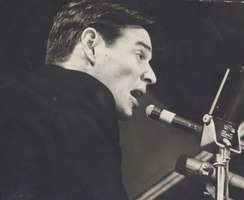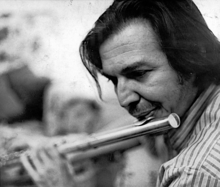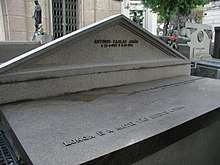Antônio Carlos Jobim
Antônio Carlos Brasileiro de Almeida Jobim (January 25, 1927 – December 8, 1994), also known as Tom Jobim (Portuguese pronunciation: [tõ ʒoˈbĩ]), was a Brazilian composer, pianist, songwriter, arranger and singer. Widely considered as one of the great exponents of Brazilian music, Jobim internationalized bossa nova and, with the help of important American artists, merged it with jazz in the 1960s to create a new sound with remarkable popular success. As such he is sometimes known as the "father of bossa nova".[1]
Antônio Carlos Jobim | |
|---|---|
 Jobim in 1965 (National Archives of Brazil) | |
| Background information | |
| Birth name | Antônio Carlos Brasileiro de Almeida Jobim |
| Also known as | Antônio Carlos Jobim, Tom Jobim, Tom do Vinícius |
| Born | January 25, 1927 Rio de Janeiro, Brazil |
| Died | December 8, 1994 (aged 67) New York City, United States |
| Genres | Bossa nova, Latin jazz, samba, MPB |
| Occupation(s) | Musician, composer, songwriter, singer |
| Instruments | Piano, guitar, flute, vocals |
| Years active | 1956–1994 |
| Labels | Verve, Warner Bros., Elenco, A&M, CTI, MCA, Philips, Decca, Sony |
| Associated acts | Vinicius de Moraes, Aloísio de Oliveira, João Gilberto, Astrud Gilberto, Stan Getz, Frank Sinatra, Ella Fitzgerald, Sting, Gal Costa, Andy Williams |
He was a primary force behind the creation of the bossa nova style, and his songs have been performed by many singers and instrumentalists within Brazil and internationally.
In 1965 his album Getz/Gilberto was the first jazz album to win the Grammy Award for Album of the Year. It also won for Best Jazz Instrumental Album – Individual or Group and for Best Engineered Album, Non-Classical. The album's single "Garota de Ipanema" ("The Girl from Ipanema"), one of the most recorded songs of all time, won the Record of the Year. Jobim has left many songs that are now included in jazz and pop standard repertoires. The song "Garota de Ipanema" has been recorded over 240 times by other artists.[2] His 1967 album with Frank Sinatra, Francis Albert Sinatra & Antônio Carlos Jobim, was nominated for Album of the Year in 1968.
Early life
Antônio Carlos Jobim was born in the middle-class district of Tijuca in Rio de Janeiro. His father, Jorge de Oliveira Jobim (São Gabriel, Rio Grande do Sul, April 23, 1889 – July 19, 1935), was a writer, diplomat, professor and journalist. He came from a prominent family, being the great nephew of José Martins da Cruz Jobim,[3] senator, privy councillor and physician of Emperor Dom Pedro II. While studying medicine in Europe, José Martins added Jobim to his last name, paying homage to the village where his family came from in Portugal, the parish of Santa Cruz de Jovim, Porto.[4][5] His mother, Nilza Brasileiro de Almeida (c. 1910 – November 17, 1989), was of Indigenous Brazilian descent from Northeastern Brazil.[6]
When Antônio was still an infant, his parents separated and his mother moved with her children (Antônio Carlos and his sister Helena Isaura, born February 23, 1931) to Ipanema, the beachside neighborhood the composer would later celebrate in his songs. In 1935, when the elder Jobim died, Nilza married Celso da Frota Pessoa (died February 2, 1979), who would encourage his stepson's career. He was the one who gave Jobim his first piano. As a young man of limited means, Jobim earned his living by playing in nightclubs and bars and later as an arranger for a recording label, before starting to achieve success as a composer.
Jobim's musical roots were planted firmly in the work of Pixinguinha, the legendary musician and composer who began modern Brazilian music in the 1930s. Among his teachers were Lúcia Branco and, from 1941 on, Hans-Joachim Koellreutter, a German composer who lived in Brazil and introduced atonal and twelve-tone composition in the country. Jobim was also influenced by the French composers Claude Debussy and Maurice Ravel, and by the Brazilian composers Heitor Villa-Lobos and Ary Barroso. The bossa nova guitar style in Jobim's music has become firmly entrenched in jazz culture.[7] Among many themes, his lyrics talked about love, self-discovery, betrayal, joy and especially about the birds and natural wonders of Brazil, like the "Mata Atlântica" forest, characters of Brazilian folklore and his home city of Rio de Janeiro.
Career
In the 1940s, Tom Jobim started to play piano in bars and nightclubs of Rio de Janeiro and in the first years of the 1950s he worked as an arranger in the Continental Studio, where he had his first composition recorded, in April 1953, when the Brazilian singer Mauricy Moura recorded Incerteza, a composition by Tom Jobim with Lyrics by Newton Mendonça.[8][9]
Jobim became prominent in Brazil when he teamed up with poet and diplomat Vinicius de Moraes to write the music for the play Orfeu da Conceição (1956). The most popular song from the show was "Se Todos Fossem Iguais A Você" ("If Everyone Were Like You"). Later, when the play was adapted into a film, producer Sacha Gordine did not want to use any of the existing music from the play. Gordine asked de Moraes and Jobim for a new score for the film Orfeu Negro, or Black Orpheus (1959). Moraes was at the time away in Montevideo, Uruguay, working for the Itamaraty (the Brazilian Ministry of Foreign Affairs) and so he and Jobim were only able to write three songs, primarily over the telephone ("A felicidade", "Frevo" and "O nosso amor"). This collaboration proved successful, and de Moraes went on to pen the lyrics to some of Jobim's most popular songs.
In 1958 the Brazilian singer and guitarist João Gilberto recorded his first album with two of the most famous songs of Tom Jobim: Desafinado and Chega de Saudade. This album inaugurates the Bossa Nova movement in Brazil. The sophisticated harmonies of his songs caught the attention of jazz musicians in the United States, principally after the first performance of Tom Jobim in the Carnegie Hall, in 1962.[10]

A key event in making Jobim's music known in the English-speaking world was his collaboration with the American jazz saxophonist Stan Getz, the Brazilian singer João Gilberto, and Gilberto's wife at the time, Astrud Gilberto, which resulted in two albums, Getz/Gilberto (1963) and Getz/Gilberto Vol. 2 (1964). The release of Getz/Gilberto created a bossa nova craze in the United States and subsequently internationally. Getz had previously recorded Jazz Samba with Charlie Byrd (1962), and Jazz Samba Encore! with Luiz Bonfá (1964). Jobim wrote many of the songs on Getz/Gilberto, which became one of the best-selling jazz albums of all time, and turned Astrud Gilberto, who sang on "Garota de Ipanema" (The Girl from Ipanema) and "Corcovado", into an international sensation. At the Grammy Awards of 1965 Getz/Gilberto won the Grammy Award for Album of the Year, the Grammy Award for Best Jazz Instrumental Album, Individual or Group and the Grammy Award for Best Engineered Album, Non-Classical. "The Girl from Ipanema" won the Grammy Award for Record of the Year. Among his later hits is "Águas de Março" (Waters of March, 1972), for which he wrote both the Portuguese and English lyrics.
Personal life
Jobim was married to Thereza Otero Hermanny on October 15, 1949, and had two children with her: Paulo Jobim (born 1950), an architect and musician, married and father of Daniel Jobim (born 1973) and Dora Jobim (born 1976); and Elizabeth "Beth" Jobim (born 1957), a painter. Jobim and Thereza divorced in 1978. On April 30, 1986, he married 29-year-old photographer Ana Beatriz Lontra, with whom he had two more children: João Francisco Jobim (1979–1998) and Maria Luiza Helena Jobim (born 1987). Daniel, Paulo's son, followed his grandfather to become a pianist and composer,[11] and performed "The Girl from Ipanema" during the opening ceremony of the 2016 Summer Olympics in Rio de Janeiro.[12]
Death

In early 1994, after finishing his album Antonio Brasileiro, Jobim complained to his doctor, Roberto Hugo Costa Lima, of urinary problems. He underwent an operation at Mount Sinai Hospital in New York City on December 2, 1994. On December 8, while recovering from surgery, he had a cardiac arrest caused by a pulmonary embolism, and two hours later another cardiac arrest, from which he died.[13] He was survived by his children and grandchildren. His last album, Antonio Brasileiro, was released posthumously three days after his death.[14]
His body lay in state until given a proper burial on December 20, 1994. He is buried in the Cemitério São João Batista in Rio de Janeiro.[15]
Legacy
Jobim is widely regarded as one of the most important songwriters of the 20th century. Many of his songs are jazz standards.
American jazz singers Ella Fitzgerald and Frank Sinatra prominently featured Jobim's songs on their albums Ella Abraça Jobim (1981) and Francis Albert Sinatra & Antônio Carlos Jobim (1967), respectively. The 1996 CD Wave: The Antonio Carlos Jobim Songbook included performances of Jobim tunes by Oscar Peterson, Herbie Hancock, Chick Corea and Toots Thielemans.
Jobim was an innovator in the use of sophisticated harmonic structures in popular song. Some of his melodic twists, like the melody insisting on the major seventh of the chord, became commonplace in jazz after he used them.[16]
The Brazilian collaborators and interpreters of Jobim's music include Vinicius de Moraes, João Gilberto (often credited as a co-creator or creator of bossa nova), Chico Buarque, Gal Costa, Elis Regina, Sérgio Mendes, Astrud Gilberto and Flora Purim. Eumir Deodato and the conductor/composer Claus Ogerman arranged many recordings of Jobim tunes.[17]
He won a Lifetime Achievement Award at the 54th Grammy Awards in 2012.[18] As a posthumous homage, on January 5, 1999, the Municipality of Rio de Janeiro changed the name of Rio's Galeão International Airport, located on Governador Island, to bear the composer's name. Galeão Airport is explicitly mentioned in his composition "Samba do Avião". In 2014, Jobim was posthumously inducted to the Latin Songwriters Hall of Fame.[19] In 2015, Billboard named Jobim as one of The 30 Most Influential Latin Artists of All Time.[20]
American contemporary jazz singer Michael Franks dedicated his 1995 album Abandoned Garden to the memory of Jobim.[21] English singer/songwriter George Michael frequently acknowledged Jobim's influence. His 1996 album Older was dedicated to Jobim,[22] and he recorded "Desafinado" on Red Hot + Rio (1996) with Astrud Gilberto.
The official mascot of the 2016 Summer Paralympics in Rio de Janeiro, Tom, was named after him.[23]
Discography and compositions
|
|
Notes
- "Rio unveils statue of father of bossa nova Tom Jobim". Euronews. 10 December 2014.
- "Ecad divulga rankings no centenario de Vinicius de Moraes". UOL. Retrieved August 8, 2014.
- Programa Roda Viva (TV Cultura), entrevista Tom Jobim Domingo, 19 de Dezembro de 1993 (PGM0385) Online transcription and video of the interview Archived July 6, 2011, at the Wayback Machine
- CORADINI, O. L.: Important families and the professional elite within brazilian medicine. História, Ciências, Saúde—Manguinhos, III (3) 425–466, November 1996 – February 1997. Online .pdf Archived June 5, 2011, at the Wayback Machine
- SILVA, Innocêncio Francisco da: Diccionario Bibliographico Portuguez: Applicaveis a Portugal e ao Brasil, Lisboa 1860, p. 62
- Cabral, Sergio (1987). Tom Jobim. : Texto de Sergio Cabral. The Archive of Contemporary Music. Rio de Janeiro : CBPO.
- Arana, Carlos (2008). Bossa Nova Guitar. ISBN 978-1423425199.
- Béhague, Gerard (2001), "Jobim, Antônio Carlos [Tom]", Oxford Music Online, Oxford University Press, doi:10.1093/gmo/9781561592630.article.44182
- "Incerteza". Jobim Institute.
- "Tom Jobim". portal.jobim.org. Retrieved 2019-09-28.
- Cohen, Aaron (September 13, 2012). "Bebel Gilberto doesn't let her family legacy be a road map". Chicago Tribune. Retrieved April 23, 2013.
- Cantor-Navas, Judy (17 August 2016). "'Girl From Ipanema' Makes Olympic Comeback". Billboard. Retrieved 6 May 2018.
- Cabral, Sergio (2008): Antônio Carlos Jobim – Uma Biografia (1st Edition). São Paulo, Brazil: IBEP Nacional. ISBN 85-7865-011-5
- "Newsweek Archives".
- The Guardian
- MacDowell, João; The Harmonic Development of Brazilian Song, Rio de Janeiro,1999.
- Red Bull Music Academy (2005) Eumir Deodato – Boy from Rio Pt. 1, Accessed December 6, 2006. Archived October 25, 2006, at the Wayback Machine
- Mendes, Sergio (January 31, 2012). "Lifetime Achievement Award: Antonio Carlos Jobim". The Recording Academy. Retrieved April 23, 2013.
- "Special Awards – Latin Songwriters Hall of Fame". Latin Songwriters Hall of Fame. 2013. Retrieved March 23, 2014.
- "The 30 Most Influential Latin Artists of All Time". Billboard. April 28, 2015. Retrieved May 1, 2015.
- O'Toole, Kit (2008-03-26). "Michael Franks's Abandoned Garden an Eloquent Tribute to Jobim". Blogcritics Music. Retrieved 2012-03-09.
- "Serious George Is Back". Newsweek. 19 May 1996.
- Rio 2016 (15 December 2014). "Rio 2016 Paralympic mascot named 'Tom'". Official Website of the Paralympic Movement. International Paralympic Committee. Retrieved 8 August 2016.
- "Browsing Discos by Date". www.jobim.org. Retrieved 2019-09-28.
References
- McGowan, Chris; Pessanha, Ricardo (2008). The Brazilian Sound: Samba, Bossa Nova and the Popular Music of Brazil (2nd ed.). Philadelphia: Temple University Press. ISBN 978-1592139293.
- Castro, Ruy (2000). Bossa Nova: The Story of the Brazilian Music That Seduced the World (1st English-Language ed.). Chicago, IL: A Capella Books. ISBN 978-1-55652-409-7.
- Cabral, Sergio (2008). Antônio Carlos Jobim – Uma Biografia (1st ed.). São Paulo, Brazil: IBEP Nacional. ISBN 978-85-7865-011-7.
- De Stefano, Gildo, Il popolo del samba, La vicenda e i protagonisti della storia della musica popolare brasiliana, preface by Chico Buarque de Hollanda, introduction by Gianni Minà, RAI-ERI, Rome 2005, ISBN 8839713484
- De Stefano, Gildo, Saudade Bossa Nova: musiche, contaminazioni e ritmi del Brasile, preface by Chico Buarque, introduction by Gianni Minà, Logisma Editore, Florence 2017, ISBN 978-88-97530-88-6
External links
- Antônio Carlos Jobim – tribute site
- Antônio Carlos Jobim – remembrance site
- Antônio Carlos Jobim discography at Discogs
- Antônio Carlos Jobim on IMDb
- Antônio Carlos Jobim at The Brazilian Sound
- Antônio Carlos Jobim – "Clube do Tom"
- Antônio Carlos Jobim – behind the scenes of the legendary bossa nova concert at Carnegie Hall in 1962 (in Portuguese)